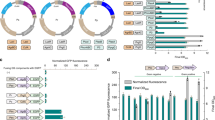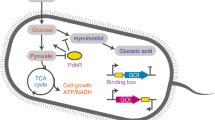Abstract
Metabolic engineering of microorganisms to produce desirable products on an industrial scale can result in unbalanced cellular metabolic networks that reduce productivity and yield. Metabolic fluxes can be rebalanced using dynamic pathway regulation, but few broadly applicable tools are available to achieve this. We present a pathway-independent genetic control module that can be used to dynamically regulate the expression of target genes. We apply our module to identify the optimal point to redirect glycolytic flux into heterologous engineered pathways in Escherichia coli, resulting in titers of myo-inositol increased 5.5-fold and titers of glucaric acid increased from unmeasurable to >0.8 g/L, compared to the parent strains lacking dynamic flux control. Scaled-up production of these strains in benchtop bioreactors resulted in almost ten- and fivefold increases in specific titers of myo-inositol and glucaric acid, respectively. We also used our module to control flux into aromatic amino acid biosynthesis to increase titers of shikimate in E. coli from unmeasurable to >100 mg/L.
This is a preview of subscription content, access via your institution
Access options
Access Nature and 54 other Nature Portfolio journals
Get Nature+, our best-value online-access subscription
$29.99 / 30 days
cancel any time
Subscribe to this journal
Receive 12 print issues and online access
$209.00 per year
only $17.42 per issue
Buy this article
- Purchase on Springer Link
- Instant access to full article PDF
Prices may be subject to local taxes which are calculated during checkout





Similar content being viewed by others
References
Alper, H., Miyaoku, K. & Stephanopoulos, G. Construction of lycopene-overproducing E. coli strains by combining systematic and combinatorial gene knockout targets. Nat. Biotechnol. 23, 612–616 (2005).
Biggs, B.W., De Paepe, B., Santos, C.N.S., De Mey, M. & Kumaran Ajikumar, P. Multivariate modular metabolic engineering for pathway and strain optimization. Curr. Opin. Biotechnol. 29, 156–162 (2014).
Holtz, W.J. & Keasling, J.D. Engineering static and dynamic control of synthetic pathways. Cell 140, 19–23 (2010).
Moon, T.S., Yoon, S.-H., Lanza, A.M., Roy-Mayhew, J.D. & Prather, K.L.J. Production of glucaric acid from a synthetic pathway in recombinant Escherichia coli. Appl. Environ. Microbiol. 75, 589–595 (2009).
Rodrigues, A.L. et al. Systems metabolic engineering of Escherichia coli for production of the antitumor drugs violacein and deoxyviolacein. Metab. Eng. 20, 29–41 (2013).
Martin, V.J.J., Pitera, D.J., Withers, S.T., Newman, J.D. & Keasling, J.D. Engineering a mevalonate pathway in Escherichia coli for production of terpenoids. Nat. Biotechnol. 21, 796–802 (2003).
Zaslaver, A. et al. Just-in-time transcription program in metabolic pathways. Nat. Genet. 36, 486–491 (2004).
Farmer, W.R. & Liao, J.C. Improving lycopene production in Escherichia coli by engineering metabolic control. Nat. Biotechnol. 18, 533–537 (2000).
Dahl, R.H. et al. Engineering dynamic pathway regulation using stress-response promoters. Nat. Biotechnol. 31, 1039–1046 (2013).
Zhou, L.-B. & Zeng, A.-P. Exploring lysine riboswitch for metabolic flux control and improvement of L-lysine synthesis in Corynebacterium glutamicum. ACS Synth. Biol. 4, 729–734 (2015).
Cardinale, S. & Arkin, A.P. Contextualizing context for synthetic biology--identifying causes of failure of synthetic biological systems. Biotechnol. J. 7, 856–866 (2012).
Van Dien, S. From the first drop to the first truckload: commercialization of microbial processes for renewable chemicals. Curr. Opin. Biotechnol. 24, 1061–1068 (2013).
Weber, W. & Fussenegger, M. Inducible product gene expression technology tailored to bioprocess engineering. Curr. Opin. Biotechnol. 18, 399–410 (2007).
Soma, Y. & Hanai, T. Self-induced metabolic state switching by a tunable cell density sensor for microbial isopropanol production. Metab. Eng. 30, 7–15 (2015).
Tsao, C.Y., Hooshangi, S., Wu, H.C., Valdes, J.J. & Bentley, W.E. Autonomous induction of recombinant proteins by minimally rewiring native quorum sensing regulon of E. coli. Metab. Eng. 12, 291–297 (2010).
Solomon, K.V., Moon, T.S., Ma, B., Sanders, T.M. & Prather, K.L.J. Tuning primary metabolism for heterologous pathway productivity. ACS Synth. Biol. 2, 126–135 (2013).
Brockman, I.M. & Prather, K.L.J. Dynamic knockdown of E. coli central metabolism for redirecting fluxes of primary metabolites. Metab. Eng. 28, 104–113 (2015).
Juminaga, D. et al. Modular engineering of L-tyrosine production in Escherichia coli. Appl. Environ. Microbiol. 78, 89–98 (2012).
Saeidi, N. et al. Engineering microbes to sense and eradicate Pseudomonas aeruginosa, a human pathogen. Mol. Syst. Biol. 7, 521 (2011).
Balagaddé, F.K. et al. A synthetic Escherichia coli predator-prey ecosystem. Mol. Syst. Biol. 4, 187 (2008).
Minogue, T.D., Wehland-von Trebra, M., Bernhard, F. & von Bodman, S.B. The autoregulatory role of EsaR, a quorum-sensing regulator in Pantoea stewartii ssp. stewartii: evidence for a repressor function. Mol. Microbiol. 44, 1625–1635 (2002).
Mutalik, V.K. et al. Precise and reliable gene expression via standard transcription and translation initiation elements. Nat. Methods 10, 354–360 (2013).
BioFAB. Biofab Data Access Client (BioFAB, 2012).
Hansen, C.A., Dean, A.B., Draths, K.M. & Frost, J.W. Synthesis of 1,2,3,4-Tetrahydroxybenzene from D-glucose: exploiting myo-Inositol as a precursor to aromatic chemicals. J. Am. Chem. Soc. 121, 3799–3800 (1999).
Werpy, T. et al. Top value added chemicals from biomass volume I—results of screening for potential candidates from sugars and synthesis gas (US Department of Energy, Washington, DC, 2004).
Yamaoka, M., Osawa, S., Morinaga, T., Takenaka, S. & Yoshida, K. A cell factory of Bacillus subtilis engineered for the simple bioconversion of myo-inositol to scyllo-inositol, a potential therapeutic agent for Alzheimer's disease. Microb. Cell Fact. 10, 69 (2011).
Moser, F. et al. Genetic circuit performance under conditions relevant for industrial bioreactors. ACS Synth. Biol. 1, 555–564 (2012).
Reizman, I.M.B. et al. Improvement of glucaric acid production in E. coli via dynamic control of metabolic fluxes. Metab. Eng. Commun. 2, 109–116 (2015).
Raman, S., Rogers, J.K., Taylor, N.D. & Church, G.M. Evolution-guided optimization of biosynthetic pathways. Proc. Natl. Acad. Sci. USA 111, 17803–17808 (2014).
Draths, K.M., Knop, D.R. & Frost, J.W. Shikimic acid and quinic acid: replacing isolation from plant sources with recombinant microbial biocatalysis. J. Am. Chem. Soc. 121, 1603–1604 (1999).
Kim, C.U. et al. Influenza neuraminidase inhibitors possessing a novel hydrophobic interaction in the enzyme active site: design, synthesis, and structural analysis of carbocyclic sialic acid analogues with potent anti-influenza activity. J. Am. Chem. Soc. 119, 681–690 (1997).
Way, J.C. & Davis, J.H. Methods and molecules for yield improvement involving metabolic engineering. US Patent Application No. 13/322,383 (2010).
Chen, K. et al. Deletion of the aroK gene is essential for high shikimic acid accumulation through the shikimate pathway in E. coli. Bioresour. Technol. 119, 141–147 (2012).
Xu, P., Li, L., Zhang, F., Stephanopoulos, G. & Koffas, M. Improving fatty acids production by engineering dynamic pathway regulation and metabolic control. Proc. Natl. Acad. Sci. USA 111, 11299–11304 (2014).
Pfleger, B.F., Pitera, D.J., Newman, J.D., Martin, V.J.J. & Keasling, J.D. Microbial sensors for small molecules: development of a mevalonate biosensor. Metab. Eng. 9, 30–38 (2007).
Studier, F.W. Protein production by auto-induction in high density shaking cultures. Protein Expr. Purif. 41, 207–234 (2005).
Wang, G. et al. Integration of microbial kinetics and fluid dynamics toward model-driven scale-up of industrial bioprocesses. Eng. Life Sci. 15, 20–29 (2015).
Brockman, I.M. & Prather, K.L.J. Dynamic metabolic engineering: new strategies for developing responsive cell factories. Biotechnol. J. 10, 1360–1369 (2015).
Venayak, N., Anesiadis, N., Cluett, W.R. & Mahadevan, R. Engineering metabolism through dynamic control. Curr. Opin. Biotechnol. 34, 142–152 (2015).
McNerney, M.P., Watstein, D.M. & Styczynski, M.P. Precision metabolic engineering: the design of responsive, selective, and controllable metabolic systems. Metab. Eng. 31, 123–131 (2015).
Shong, J., Huang, Y.-M., Bystroff, C. & Collins, C.H. Directed evolution of the quorum-sensing regulator EsaR for increased signal sensitivity. ACS Chem. Biol. 8, 789–795 (2013).
St-Pierre, F. et al. One-step cloning and chromosomal integration of DNA. ACS Synth. Biol. 2, 537–541 (2013).
Kuhlman, T.E. & Cox, E.C. Site-specific chromosomal integration of large synthetic constructs. Nucleic Acids Res. 38, e92 (2010).
Shong, J. & Collins, C.H. Engineering the esaR promoter for tunable quorum sensing- dependent gene expression. ACS Synth. Biol. 2, 568–575 (2013).
Baba, T. et al. Construction of Escherichia coli K-12 in-frame, single-gene knockout mutants: the Keio collection. Mol. Syst. Biol. 2, 2006.0008 (2006).
Reisch, C.R. & Prather, K.L.J. The no-SCAR (Scarless Cas9 Assisted Recombineering) system for genome editing in Escherichia coli. Sci. Rep. 5, 15096 (2015).
Salis, H.M. The ribosome binding site calculator. Methods Enzymol. 498, 19–42 (2011).
Acknowledgements
We thank C. Collins at Rensselaer Polytechnic Institute (Troy, New York, USA) for providing plasmids and parts for the Esa QS system. In addition, we thank S. Arussy for help in preparing strains for glucaric acid production, and m2p-labs for the loan of a BioLector unit. This work was supported by the US National Science Foundation through the CAREER program (I.M.B.R. and K.L.J.P., Grant No. CBET-0954986), the Graduate Research Fellowship program (A.G.), the Synthetic Biology Engineering Research Center (SynBERC; A.G. and K.L.J.P., Grant No. EEC-0540879), and the Division of Molecular and Cellular Biosciences (A.G. and K.L.J.P., Grant No. MCB-1517913); by the Biotechnology Training Program of the National Institutes of Health (I.M.B.R., Grant No. T32GM008334); and by the USDA National Institute of Food and Agriculture Postdoctoral Fellowship (C.R.R., Grant No. 2013-67012-21022).
Author information
Authors and Affiliations
Contributions
A.G., I.M.B.R., C.R.R. and K.L.J.P. designed and performed the experiments and analyzed the data. A.G., I.M.B.R. and K.L.J.P. wrote the manuscript.
Corresponding author
Ethics declarations
Competing interests
A.G., I.M.B.R. and K.L.J.P. are co-inventors on a patent application that includes the reported methods.
Supplementary information
Supplementary Text and Figures
Supplementary Notes 1–3, Supplementary Figures 1–14, Supplementary Tables 1, 3, 4, and 5 (PDF 1705 kb)
Supplementary Table 2
All strains and corresponding genotypes relevant in this study (PDF 309 kb)
Supplementary Table 6
Promoter, 5′UTR and degradation tag sequences for the expression cassettes used in this study (PDF 71 kb)
Rights and permissions
About this article
Cite this article
Gupta, A., Reizman, I., Reisch, C. et al. Dynamic regulation of metabolic flux in engineered bacteria using a pathway-independent quorum-sensing circuit. Nat Biotechnol 35, 273–279 (2017). https://doi.org/10.1038/nbt.3796
Received:
Accepted:
Published:
Issue Date:
DOI: https://doi.org/10.1038/nbt.3796
This article is cited by
-
Synthetic microbe-to-plant communication channels
Nature Communications (2024)
-
Production of d-glucaric acid with phosphoglucose isomerase-deficient Saccharomyces cerevisiae
Biotechnology Letters (2024)
-
Construction of a plasmid-free l-leucine overproducing Escherichia coli strain through reprogramming of the metabolic flux
Biotechnology for Biofuels and Bioproducts (2023)
-
Engineered autonomous dynamic regulation of metabolic flux
Nature Reviews Bioengineering (2023)
-
Redox signaling-driven modulation of microbial biosynthesis and biocatalysis
Nature Communications (2023)



